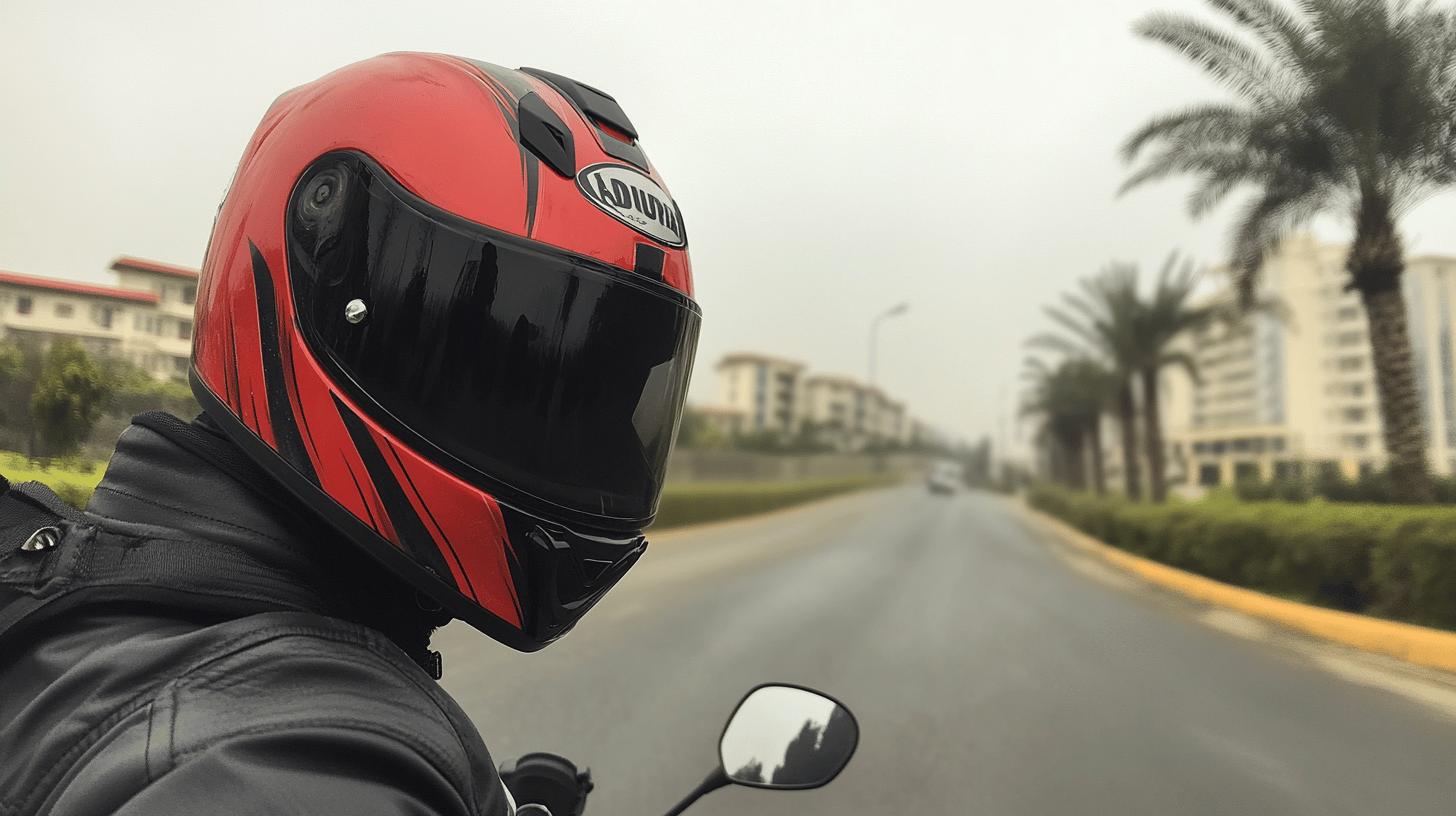When strapping on a helmet, is it mere decor or a guardian angel for motorcyclists? These protective cocoons don't just cap off your gear—they're vital lifelines.
The stark reality is that motorcyclists face a traffic fatality rate 27 times greater than car occupants per mile traveled. Helmets cut the risk of head injury by 69% and slash the death rate by 42% during crashes.
They transform potential tragedy into survival, making them indispensable for any rider. Delve into why helmets stand as essential shields in the world of motorcycle safety.
The Role of Motorcycle Helmets in Accident Survival Rates

Motorcycle helmets are pivotal in reducing the likelihood of severe injuries and fatalities during accidents. The effectiveness of helmets in preventing head injuries is unequivocal, with a 69% reduction in risk.
They also decrease the risk of death by 42% for riders involved in crashes. These statistics underscore the critical function helmets serve in safeguarding motorcyclists' lives.
Given the high stakes, the implementation of helmet use is a paramount safety measure for all riders aiming to mitigate the devastating consequences of crashes.
-
Helmets reduce head injury risk by 69%.
-
Wearing a helmet decreases the risk of death by 42%.
-
Motorcyclists have a fatality rate 27 times greater than car occupants per mile traveled.
-
Helmets protect against severe head trauma and brain injuries.
-
Proper helmet use significantly lowers medical costs associated with accidents.
Motorcyclists face substantially higher risks on the road compared to car occupants. The traffic fatality rate for motorcyclists is 27 times greater per mile traveled. This stark contrast highlights the vulnerability of riders who lack the protective shell that vehicles provide.
Helmets act as a vital line of defense, offering crucial protection against the inherent hazards of motorcycle riding. These risks necessitate a heightened awareness of safety measures, with helmets being an indispensable component in reducing the probability of life-altering outcomes from accidents.
Legal Requirements and Motorcycle Helmet Laws

Motorcycle helmet laws vary significantly across the United States, reflecting diverse legislative approaches to rider safety. Some states mandate that all riders wear helmets, while others impose requirements only for specific age groups or types of riders.
For instance, states like California and New York enforce universal helmet laws, requiring all motorcyclists to wear helmets. In contrast, states such as Illinois and Iowa have no helmet laws, leaving the decision to individual riders. This inconsistency in legal requirements underscores the importance of understanding the specific helmet laws applicable in each state.
| State | Helmet Law Status |
|---|---|
| California | Universal Helmet Law |
| New York | Universal Helmet Law |
| Texas | Partial Law (under 21) |
| Illinois | No Helmet Law |
| Florida | Partial Law (under 21) |
The presence or absence of helmet laws has a profound impact on accident statistics and safety outcomes. In states with mandatory helmet laws, there is a noticeable reduction in fatalities and severe injuries resulting from motorcycle accidents.
For example, in South Carolina, where there is no universal helmet law, motorcycles account for about 10% of all vehicle accidents, with nearly 100 fatalities annually. A significant 66% of those fatalities involve riders who were not wearing helmets.
These figures highlight the vital role helmet laws play in enhancing rider safety and reducing the likelihood of catastrophic injuries and deaths.
Technology and Materials in Modern Motorcycle Helmets

The evolution of motorcycle helmet technology has significantly enhanced rider safety and comfort. Early helmets, primarily made from basic materials, offered minimal protection. Today, advanced materials and innovative designs have transformed helmets into sophisticated protective gear.
Modern helmets incorporate cutting-edge technology, ensuring that riders are better shielded from the various dangers encountered on the road.
Visor and Sun Protection
Modern helmets often feature integrated visors that effectively combat sun glare and shield riders from debris. These visors are typically made from high-impact-resistant materials, providing clear vision without compromising safety.
Anti-fog and UV-protection coatings are common, further enhancing their utility in diverse weather conditions, thus ensuring that riders maintain optimal visibility and protection.
Lightweight and Aerodynamic Design
The use of advanced materials like carbon fiber and polycarbonate has allowed manufacturers to create helmets that are both lightweight and aerodynamic. These materials reduce the overall weight of the helmet, minimizing neck fatigue during long rides.
Aerodynamic designs reduce wind resistance, enhancing stability and comfort at high speeds. This combination of features ensures that riders can enjoy a safer and more comfortable journey without unnecessary physical strain.
Ventilation and Reflective Features
Effective ventilation systems in modern helmets are crucial for rider comfort, preventing overheating during extended rides. Strategically placed vents promote airflow, keeping the interior cool and dry.
Additionally, reflective materials are often incorporated into the helmet design, significantly increasing visibility to other motorists. This feature is particularly beneficial in low-light conditions, reducing the risk of accidents by making the rider more noticeable.
The advancements in helmet technology and materials have a profound impact on enhancing rider safety and comfort. By addressing critical areas such as visibility, weight, and ventilation, modern helmets provide comprehensive protection while ensuring a comfortable riding experience.
These innovations not only protect the rider but also enhance the overall riding experience, making helmets an indispensable component of motorcycle safety gear.
The Importance of Helmet Fit, Comfort, and Style

A properly fitted helmet is crucial for both safety and comfort during rides. Why is a well-fitted helmet important for safety?
A well-fitted helmet prevents vision obstruction and ensures that the helmet stays securely in place during a ride, minimizing movement that could distract the rider or fail to protect adequately during an impact.
Comfort is equally important; an uncomfortable helmet can lead to distractions, reduced focus, and fatigue, all of which increase the risk of accidents. Therefore, investing in a helmet that fits snugly, without being too tight, is essential for optimal protection and focus on the road.
-
Measure your head circumference for accurate sizing.
-
Try on several helmets to find one that feels comfortable.
-
Ensure the helmet sits level on your head and doesn't tilt.
-
Check for snugness: no gaps and a tight fit all around.
-
Pay attention to pressure points; avoid helmets that cause discomfort.
-
Verify that the chin strap is adjustable and secure.
Style and design play a significant role in enhancing rider confidence and satisfaction. Helmets are available in a multitude of designs and colors, allowing riders to express their personal style and preferences.
The ability to choose a helmet that matches one's personality or complements their motorcycle can boost confidence, making the riding experience more enjoyable. While style should never compromise safety, finding a balance between the two can make wearing a helmet a more positive and satisfying experience, encouraging consistent use among riders.
Motorcycle Helmets as Lifesaving Equipment

Motorcycle helmets are indispensable in the realm of injury prevention, serving as critical lifesaving equipment for riders. How effective are helmets in preventing head injuries? Helmets significantly reduce the risk of severe head injuries, which are often a leading cause of death and disability in motorcycle accidents.
By absorbing impact forces, helmets protect the skull and brain, crucially minimizing the likelihood of traumatic brain injuries. This protective attribute underscores the helmet's role as an essential component of a rider's safety gear, effectively reducing the severity of injuries sustained in crashes.
-
Collisions involving other vehicles
-
Accidents caused by road hazards like potholes
-
Sudden stops leading to over-the-handlebar flips
-
Incidents with wildlife crossing roads
-
Skidding on wet or icy surfaces
-
High-speed crashes
- Urban area accidents with dense traffic
Beyond head injury prevention, helmets offer additional protective features that enhance rider safety. What other protections do helmets provide? Helmets shield riders from flying debris and insects, which can obstruct vision and lead to accidents.
A clear visor helps maintain an unobstructed view of the road, crucial for safe navigation. By providing a barrier against environmental elements, helmets not only protect the rider's eyes but also prevent distractions that could compromise safety.
Real-world experiences further highlight the lifesaving potential of helmets. Numerous testimonials from riders who survived crashes attribute their survival to wearing a helmet. For instance, some riders have recounted how helmets saved them from severe head injuries in high-speed collisions or when thrown from their bikes.
These firsthand accounts emphasize the importance of wearing a helmet consistently, reinforcing its role as a decisive factor in reducing the impact of accidents and saving lives. The real-world evidence and personal stories of survival serve as powerful reminders of the helmet's efficacy as a lifesaving tool.
Final Words
In the action of understanding motorcycle helmet importance, it becomes evident they drastically reduce severe injuries and fatality risks. They save lives, highlighted by helmet technology, laws, and proper fit.
Though laws vary, wearing helmets remains crucial for all riders. Advancements in design also enhance comfort, making helmets more user-friendly and stylish. Understanding why motorcycle helmets are so important empowers riders to make informed choices, ensuring safer and more enjoyable journeys.
FAQ
Why are motorcycle helmets so important?
Motorcycle helmets are critical for rider safety, reducing the risk of head injury by 69% and decreasing the risk of death by 42% during accidents.
Do motorcycle helmets reduce the risk of death?
Yes, they decrease the risk of death by 42% in crashes, highlighting their role as lifesaving gear for motorcyclists.
What is the main function of a motorcycle helmet?
The main function of a motorcycle helmet is to protect the rider's head from severe injuries and fatalities during an accident.
What are the advantages of wearing a helmet?
Wearing a helmet offers key advantages: reducing head injury risk, saving lives, increasing visibility, providing debris protection, and enhancing confidence.
Why should I wear a helmet when motorcycling?
Wearing a helmet provides critical head protection, prevents serious injury, and increases survival chances in the event of a crash.
What are the disadvantages of wearing a helmet?
Some riders find helmets uncomfortable due to weight, ventilation issues, or limited styles, but modern designs address these concerns with improved materials and fit.
How do helmet laws impact motorcycle safety?
Helmet laws vary by state, but those with strict laws have lower fatality rates, demonstrating the importance of legal mandates in enhancing rider safety.
What advancements are featured in modern motorcycle helmets?
Modern helmets feature visors for sun protection, lightweight and aerodynamic designs, ventilation systems, and reflective materials that all enhance safety and comfort.
How can helmet style influence a rider's experience?
A helmet that aligns with a rider's style and fits well enhances confidence and satisfaction during rides, allowing personal expression without compromising safety.

Mark Anderson is a trusted expert with over 25 years of riding experience. At 56, his deep knowledge of long-distance touring and participation in major motorcycle rallies makes him a reliable source for gear recommendations on ProtectiveGearz. Mark’s decades of firsthand experience ensure his advice is authoritative and valuable to riders seeking expert guidance.



